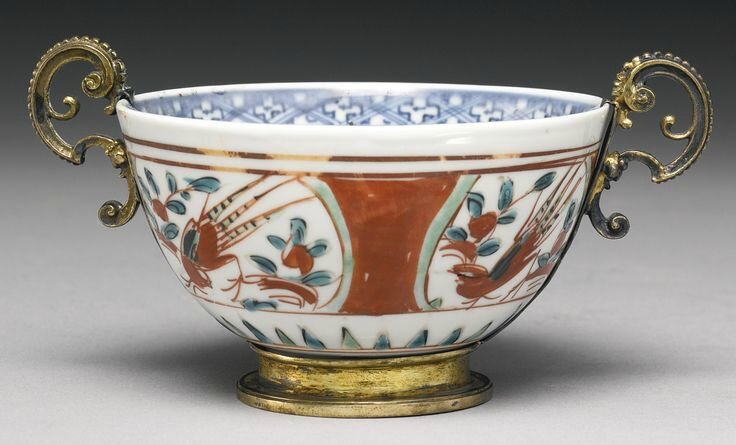A rare and important wucai bowl with silver gilt mounts, Ming dynasty, Jiajing period
A rare and important wucai bowl with silver gilt mounts, Ming dynasty, Jiajing period. Estimate 60,000 — 80,000 USD. Photo Sotheby's.
painted on the exterior with four reserves of pheasant and foliage in iron red, green and turquoise on an iron-red ground, the interior in underglaze blue with a central medallion of a small water bird amid lotus flowers enclosed by double lines and a diaper band around the rim, the silver gilt mounts late 16th- early 17th century, possibly Augsburg or Nuremberg - Diameter 4 1/8 in., 10.4 cm
Provenance: Collection of R.W. Brandt by 1923.
Collection of Mr. and Mrs. Alfred Clark.
Sotheby's London, 24th March 1953, lot 60.
Bluett & Sons, London, 1953.
Collection Charles J. Aron.
Bluett & Sons, London, 1963.
Collection of Mrs. Leonard Dreyfus, 1963.
Ralph M. Chait Galleries, Inc., New York, 1980s.
Exhibition: "Polychrome Porcelain of the Ming and Manchu Dynasties", Oriental Ceramic Society, London, 1950, no. 119.
"The Arts of the Ming Dynasty", Oriental Ceramic Society London 15th November - 14th December 1957, no. 219. (Lent by C. J. Aron)
Literature: R.L. Hobson, The Wares of the Ming Dynasty, New York, 1923, pp. 116-117, pl. 6, fig. 2.
Warren E. Cox, The Book of Pottery and Porcelain, vol. I, New York, 1970, pl. 140 and p. 485.
Roy Davids & Dominic Jellinek, Provenance, England, 2011, p. 50.
R. L. Hobson,The Wares of the Ming Dynasty, 1923
Warren Cox,The Book of Pottery and Porcelain, 1970
The Arts of the Ming Dynasty, OCS, London
Notes: The present piece boasts an illustrious provenance. It has belonged to some of the best known collections of the 20th century and been published and exhibited multiple times. It represents a fine example of the earliest presence of Chinese porcelain in Europe and the silver gilt mounts, contemporary with the porcelain, attest to the high value and significance of such exotic and rare treasure. Chinese porcelain was an exotic and highly valued product in 16th-century Europe. An unknown commodity, porcelain was considered a miraculous oddity from distant lands such as ostrich eggs, nautilus or trochus shells, coconut or gourd cups, and duly embellished with expensive silver or gold mounts. It would have made a handsome sideboard ornament or could have been part of a collector's 'cabinet of curiosities'.
At the time the bowl was exported from China in the second half of the 16th century, there were two primary routes to Europe; Portuguese traders based in Macao shipped to Lisbon while the Spanish imported luxury items from the east via Central America and shipped to Seville. Chinese porcelain constituted a small fraction of this trade and its expense and rarity ensured that it was available to only the wealthiest patrons. First and foremost among them was Philip II of Spain who owned the largest collection in Europe at the time - some 3,000 pieces of which none remain having been gifted, lost or destroyed. As diplomatic gifts Chinese porcelain found its way into many of the leading European royal and noble houses. Comparable examples of mounted Jiajing period bowls include the blue and white "Trenchard Bowl" and an iron-red and gold 'kinrande' bowl mounted as a stemcup both in the Victoria and Albert Museum, London, the latter illustrated in Stacy Pierson, From Object to Concept, Global Consumption and the Transformation of Ming Porcelain, Hong Kong, 2013, fig. 2.7; a blue and gilt 'Kinrande' bowl with similar mounts in the Metropolitan Museum, New York illustrated in Suzanne G. Valenstein, A Handbook of Chinese Ceramics, New York, 1989, p. 178, no. 174. a blue and white cup with gold decoration and Augsburg mounts is preserved in the Church of Santa Maria de los Corporales de Daroca, Zaragoza Spain, illustrated in Cinta Krahe, "Chinese Porcelain in Spain During the Habsburg Dynasty", Transactions of the Oriental Ceramic Society, vol. 77, Hainault, England, 2014, p. 30. Few examples of comparable significance have come on the market in recent years. An important Wanli periodwucai wine ewer and cover with period mounts, reputedly from the collection of Elizabeth I, sold in our Hong Kong rooms 8th April 2007, lot 765.
Sotheby's. Important Chinese Works of Art, New York, 17 mars 2015, 02:00 PM

/https%3A%2F%2Fprofilepics.canalblog.com%2Fprofilepics%2F1%2F0%2F100183.jpg)
/https%3A%2F%2Fstorage.canalblog.com%2F03%2F02%2F119589%2F96711876_o.jpg)
/https%3A%2F%2Fstorage.canalblog.com%2F11%2F31%2F119589%2F94773502_o.jpg)
/https%3A%2F%2Fstorage.canalblog.com%2F20%2F83%2F119589%2F94772815_o.jpg)
/https%3A%2F%2Fstorage.canalblog.com%2F26%2F72%2F119589%2F75604929_o.jpg)
/https%3A%2F%2Fstorage.canalblog.com%2F59%2F60%2F119589%2F26458628_o.jpg)










/image%2F1371349%2F20240325%2Fob_f3f664_telechargement-7.jpg)
/image%2F1371349%2F20240325%2Fob_bb86e3_telechargement.jpg)
/http%3A%2F%2Fstorage.canalblog.com%2F43%2F39%2F119589%2F129858579_o.jpg)
/http%3A%2F%2Fstorage.canalblog.com%2F66%2F03%2F119589%2F129677087_o.jpg)